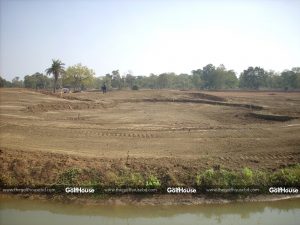One of the reoccurring discussions in golf, be it with architects, clients or just keen golfers is about the length of golf courses. It is a matter of fact that the golf ball now travels much further than it did 20 years ago. At about the same time the driver went from being wood to metal and its size increased, the ‘trampoline effect’ became a new buzz word and shafts became lighter.
With the arrival of this new equipment also arrived a new type of professional golfer, an explosive athlete stronger and much fitter than the average professional golfer of the years gone by. How much the distance improvement is equipment and how much is the athlete hitting the ball is open for debate. Whoever or whatever is to blame the impact on golf design is something no one would have anticipated at the time golf ball suddenly started flying further.
Golf clubs quickly started adding yards to golf courses as they tried to ensure that their course, its par and its’ challenge remained relevant. In 1997 the Augusta National Golf Club (USA) , home of the US Masters played at 6,925 yards, less than 20 years later it played at 7,435 yards a distance increase of over 500 yards. The first course and home of golf, the Old Course at St Andrews has had similar extensions. For the 1995 Open the course played at 6,993 yards, 20 years later it had been extended to 7,305 yards. Some courses haven’t been able to add length, they have had to reduce the par score of some holes.
At the same time the golf courses started getting longer, two of golf’s most precious requirements become more of a commodity, that being land and water. Longer golf courses require more land and more water not to forget, more fertilisers, more maintenance and the list goes on.
While the improvements in equipment have seen the golf ball fly straighter and be easier to hit, all of which is fantastic, it has been the more skilled and/or faster swinging golfers who have seen the most significant change.
The addition of length to courses has seen extra tees required, so as to accommodate the length discrepancy between golfers and keep the courses relevant to all golfers, there by adding further costs to clubs, courses and developers.
I would argue that the creation of longer courses has discriminated against the majority of golfers and made the courses easier for long hitters and impossible for the rest. Golf is a strategic sport where the player is required to use their skill, ingenuity and thought processes to work their way through the challenges of each hole, make a hole long and the only thought process is to hit the ball as far (and hopefully straight) as possible then do the same again.

Some argue that it is responsibility of the sports’ governing bodies to rein in the equipment, for numerous reasons this won’t happen. And maybe it shouldn’t, human evolution has been about improvement and so has golf. The administrators didn’t stop the move from hickory to steel shafts, or from the feathery to gutta percher to haskel, to rubber core balls, or the creation of the sand wedge. All improvements that made scoring easier and the ball go further. In 1900 the 40th open was won by J. H. Taylor achieved his 3rd victory with a record 309 shots almost an improvement of 13%. A century later Tiger Woods won with a record score of 269, 40 shots better than Taylor.
Also other sports haven’t frozen advances in equipment as it has seen records break. In the same 100 years the 100m men sprint time has gone from 10.6 seconds to 9.58 a change of 9.5%. In that time tracks have improved, running shoes changed and clothing got less wind resistant. I don’t hear a call for an extra 10 yards to be added to the running track. And what about cricket, the new bats could soon be used to launch astronauts.
However golf is somewhat different to other sports, length can be such a discriminating factor and being 20 or30 yards can make such a difference. Add 15 yards to your tee shot and assuming an average of 14 driver tee shots that makes the course 210 yards shorter. Almost like playing from a forward setoff tees while your competitors are left behind on the back plates.
Let’s accept that golf equipment and ball distance won’t be parred back and at the same time stop adding crazy yardage to golf courses. The game cannot afford the additional land or resource wastage. More land, means more maintenance, more water, more fertiliser and on it goes. Let’s accept that many course and tournament records are going to be broken. And let’s get course yardage back to 7,000 yards (maximum) and use the other components of the game of golf to challenge the player.
The players’ strategy and all round skills should be the test as should the challenge of the prevailing conditions. Holes should be designed where the golfer has to make tee shot decisions that then impact on approach shot decisions and / or putting. The game is about options, playing angles and shot selection.
Imagine a golf hole of 350 yards with a variety of strategically placed hazards, hazards carefully placed so as the closer one wants to drive the ball to the green the greater the risk, but alas the golfer who lays up, too far back faces other approach shot challenges. This same hole has width where the middle of the fairway may be easy to find, but it leaves a difficult approach angle, it’s a hole on closer inspection playing closer to a bunker or water hazard sets up the best approach. It’s a golf hole where the ground is firm so as only a well struck shot stops. A golf course with bounce and run is the friend of the short hitter, the foe of the boomer. The green on this hole is firm and reasonably fast, its’ contours demand that putting from one spot is much easier than another. This same hole will tomorrow need to be played differently due to the pin location or the wind direction. This is a hole where golfers are tempted and intimidated in the same breath. And this same hole is playable to golfers of different skill levels, in fact someone who barely gets the ball in the air can play it and have fun, while at the same time the skilled golfer with all the shots is asked to use them. Now that sounds like the type of hole we should see more of.
I recently read of the worlds’ 10 longest courses, all over 8,000 yards and all built or modified in the last 10 years. The all seem to proudly wear their “over 8,000 yard” badge proudly, as if they had found some secret. If the answer to a great golf course is excessive length golf architecture would be evaluated with tape measures not prose and opinion. Rather these courses should recognised as wastes of land and resources, where the designers ran out of ideas and forgot what this great game is about.
At Pacific Coast Design we are currently working on several projects where length is the last thing discussed. In fact these projects are where minimum land use while creating a championship quality golf course is the goal. One of these courses in on 105 acres and measures over 6,500 yards –par 72, the other on similar acreage will play at over 6,100. Another project sees the redevelopment of an old course with the golf land use area reduced to accommodate further real estate expansion.
As a designer the challenge of using design elements apart from length to defend par is great fun. Creating holes that look easy but play hard, holes that tempt and reward, tempt and punish and holes that have numerous shot options, angles of play and scoring opportunities is what golf should be about.
I once read a survey of the worlds’ leading golfers who were asked their favourite holes. It was amazing that nearly all of them named holes of short to moderate length, where strategy and shot selection are seen as fundamentals to playing the hole. Further to this argument look at a list of the worlds’ 20 best golf courses, average length 6971yards.
Let’s accept that golfers can hit the ball a long way, but don’t let us throw the baby out with the bath water. We need to use design and course set up to challenge the golfer and let them have shot length as an option in their bag but don’t let it design the golf course.













